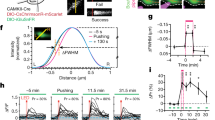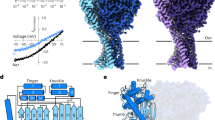Abstract
ETHANOL potentiates the postsynaptic voltage response to acetylcholine at mammalian and amphibian neuromuscular junctions1–4, by prolonging the duration of the postsynaptic conductance change5–7. At these synapses, hyperpolarisation also increases the time constant of decay (τ) of end-plate currents8–14. Because of this voltage sensitivity, it was proposed15 that the rate-limiting reaction in the decay of end-plate currents involves the relaxation of membrane proteins, which undergo a change in dipole moment normal to the field direction as they change conformation. The magnitude and direction of the change in dipole moment then determines the effect of electric field on α, the reaction rate, α ( = τ−1) would be proportional to exp (Vμ) (ref. 15) where V is membrane potential and μ the dipole moment change normal to the field direction. It has been suggested that the prolonged decay of end-plate currents produced by ethanol is due to increase by ethanol of the dielectric constant of the environment of receptors6, which lowers the rate of reactions involving a decrease in dipole moment16 and hence increases τ. In some arthropods, including crayfish, crab and locust, there is evidence that glutamate acts as an excitatory transmitter at neuromuscular junctions17,18. Also, the decay of excitatory postsynaptic currents in crayfish19 and locusts20 has the opposite voltage sensitivity to that found at amphibian neuromuscular junctions: hyper-polarisation reduces τ, suggesting that the rate-limiting reaction in the decay of conductance at these ‘glutamate’ synapses could be associated with a change in dipole moment which is opposite to that seen at amphibian neuromuscular junctions. Ethanol could then have an opposite effect at these two types of synapse, and depress synaptic transmission at glutamate synapses. We report here results of our study of spontaneous miniature excitatory junctional currents (MEJCs) in the crab, which confirm this hypothesis.
This is a preview of subscription content, access via your institution
Access options
Subscribe to this journal
Receive 51 print issues and online access
$199.00 per year
only $3.90 per issue
Buy this article
- Purchase on Springer Link
- Instant access to full article PDF
Prices may be subject to local taxes which are calculated during checkout
Similar content being viewed by others
References
Gage, P. W. J. Pharmac. exp. Ther. 150, 236–243 (1965).
Inoue, F. & Frank, G. B. Br. J. Pharmac. 30, 186–193 (1967).
Okada, K. Jap. J. Physiol. 17, 245–261 (1967).
Okada, K. Jap. J. Physiol. 20, 97–111 (1970).
McBurney, R. N. & Gage, P. W. Proc. Aust. physiol. pharmac. Soc. 3, 209 (1972).
Gage, P. W., McBurney, R. N. & Schneider, G. T. J. Physiol., Lond. 244, 409–429 (1975).
Quastel, D. M. J. & Linder, T. M. in Molecular Mechanisms of Anaesthesia (ed. Fink, B. R.) 1, 157–165 (Raven, New York, 1975).
Takeuchi, A. & Takeuchi, N. J. Neurophysiol. 22, 395–411 (1959).
Gage, P. W. & Armstrong, C. M. Nature 218, 363–365 (1968).
Kordas, M. J. Physiol., Lond. 204, 493–502 (1969).
Magleby, K. L. & Stevens, C. F. J. Physiol., Lond. 223, 151–171 (1972).
Gage, P. W. & McBurney, R. N. J. Physiol., Lond. 225, 79–94 (1972).
Gage, P. W. & McBurney, R. N. J. Physiol., Lond. 244, 385–407 (1975).
Anderson, C. R. & Stevens, C. F. J. Physiol., Lond. 235, 655–691 (1973).
Magleby, K. L. & Stevens, C. F. J. Physiol., Lond. 223, 173–197 (1972).
Glasstone, S., Laidler, K. J., Eyring, H. The Theory of Rate Processes (McGraw-Hill, New York, 1941).
Kravitz, E. A., Slater, C. R., Takahashi, K., Bownds, N. D. & Grossfeld, R. M. in Excitatory Synaptic Mechanisms (eds Andersen, P. & Jansen, J.) 85–94 (Universitetsforlaget, Oslo, 1970).
Gerschenfeld, H. M. Physiol. Rev. 53, 1–119 (1973).
Dudel, J. Pflügers Arch. 352, 227–241 (1974).
Anderson, C. R., Cull-Candy, S. G. & Miledi, R. Nature 261, 151–153 (1976).
Atwood, H. L., Hoyle, G. & Smyth, T. J. Physiol., Lond. 180, 449–482 (1965).
Kordas, M. J. Physiol., Lond. 224, 317–332 (1972).
Crawford, A. C. & McBurney, R. N. J. Physiol., Lond. 254, 47–48P (1976).
Crawford, A. C. & McBurney, R. N. J. Physiol., Lond. 258, 205–226 (1976).
Barker, J. L. Brain Res. 92, 35–55 (1975).
Chase, R. Comp. Biochem. Physiol. 506, 37–40 (1975).
Adams, D. J., Gage, P. W. & Hamill, O. P. Proc. Aust. Physiol. pharmac. Soc. 7, 71P (1976).
Faber, D. S. & Klee, M. R. Brain Res. 104, 347–353 (1976).
Eidelberg, E. & Wooley, D. F. Archs int. Pharmacodyn. Ther. 185, 388–396 (1970).
Gage, P. W. & McBurney, R. N. J. Memb. Biol. 12, 247–272 (1973).
Gage, P. W. & Hamill, O. P. Neurosci. Lett. 1, 61–65 (1975).
Gage, P. W. & Hamill, O. P. Bri. J. Pharmac. 57, 263–272 (1976).
Torda, T. A. & Gage, P. W. Anaesthesia and Intensive Care, 4, 199–202 (1976).
Author information
Authors and Affiliations
Rights and permissions
About this article
Cite this article
ADAMS, D., GAGE, P. & HAMILL, O. Ethanol reduces excitatory postsynaptic current duration at a crustacean neuromuscular junction. Nature 266, 739–741 (1977). https://doi.org/10.1038/266739a0
Received:
Accepted:
Issue Date:
DOI: https://doi.org/10.1038/266739a0
This article is cited by
-
Glutamate receptor changes in brain synaptic membranes from human alcoholics
Neurochemical Research (1990)
-
Postsynaptic actions of ethanol and methanol in crayfish neuromuscular junctions
Pfl�gers Archiv European Journal of Physiology (1984)
-
Spontaneous junctional currents inDrosophila muscle fibres: Effects of temperature, membrane potential and ethanol
Experientia (1979)
Comments
By submitting a comment you agree to abide by our Terms and Community Guidelines. If you find something abusive or that does not comply with our terms or guidelines please flag it as inappropriate.



